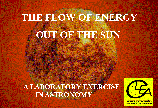

 |
Required Windows SoftwareThis is a zip file that contains an .exe file that will install itself when you run it on your computer
|
||
| Purpose: To illustrate the statistical
nature of radiative transfer in stellar interiors and stellar atmospheres.
To show how photons diffuse in a random- walk pattern from the core of
a star . To show how spectral lines are formed by random processes of absorption
and re-emission in its atmosphere.
This software contains several animated simulations that show photons in slow motion as they interact with matter and are redirected due to random processes of scattering, absorption, and re-emission. Students view the animations and measure the statistics of these processes. Each simulation can be run independently, or the entire set can be used as a full class exercise. One set of simulations deals with the scattering of photons in the interior of a star. The program demonstrates the random walk patter of a photon generated in a simulated star as it makes its way to the surface. Students can vary the number of layers in the star to see how the number of interactions and the total length of the photon's journey vary in response. They can also shoot a pulse of up to a thousand photons all at once to see how the original spike diffuses out in an extended period of time. Another set of simulations illustrates the transfer of radiation and the formation of spectral lines in the atmospheres of stars. In these programs, student can investigate the random nature of absorption processes, noting that photons whose energies correspond to electronic transitions of the atom seldom travel straight through a gas of those atoms. Students can experiment to see how many "line" photons make it through undeflected, as opposed to "continuum" photons, which travel straight through most of the time. They can experiment with samples of different gases. For a given gas, they can vary the photon energy, and by shooting photons through the gas and plotting how many make it through as a function of energy, they can learn how the statistics of a large number of photon interactions produce the dark absorption lines we see in the spectra of stars. |